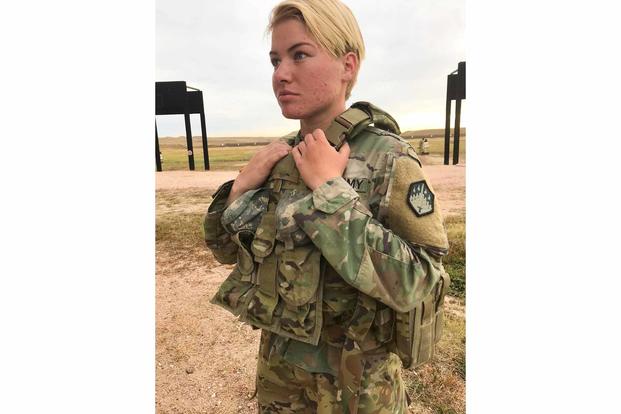For the first time in her career, Army Maj. Melissa Elledge can stand up and feel her legs after sitting for an hour while wearing body armor.
At 5 feet, 3 inches tall and 120 pounds, Elledge's body armor has never fit correctly. The plates rested on her legs while sitting, cutting off her circulation. Now, the assistant product manager with Program Executive Office Soldier is at Joint Base Lewis-McChord in Washington state, where 38 men and women are testing plates, vests, ballistic shirts, helmets and other systems cut specifically for smaller-stature troops.
"The awe that they are expressing in their maneuverability is unreal," Elledge said Wednesday at a virtual event on better-fitting body armor hosted by the Iowa Technology Institute.
Read Next: 1 Crew Member Hurt After Bullet Strikes Air Force Helicopter Over Virginia
The Army has been working to update its soldier protection system for women and men who are smaller in size. As the military closes on the five-year point since women have been able to serve in combat positions, Sen. Joni Ernst, an Iowa Republican and retired National Guard officer, said the effort is long overdue.
The senator recently introduced the Female Body Armor Modernization Act to ensure women are getting proper protective equipment. At the Wednesday event, Ernst recalled seeing female soldiers opening their ill-fitting vests while deployed so they could complete their missions.
"That's something we were always concerned about, always correcting," she said. "... You cannot have anyone not properly protected."
The soldiers testing the Army's new equipment at JBLM include 21 men and 17 women. Two of the women are infantry soldiers fresh out of training at Fort Benning, Georgia.
"These young ladies have spent 22 weeks ... with legacy ill-fitting, sometimes not-fitting, equipment," Elledge said.
Now, the Army's flame-resistant ballistic combat shirt, which provides soft-armor protection in the shoulder and upper arms, is no longer unisex. Women can get the shirt in five sizes that account for different hip shapes and female hairstyles, said Lt. Col. Stephen Miller, a product manager for soldier protective equipment with Army PEO Soldier.
Similarly, the modular scalable vest and vital torso protection plates now come in three new sizes: small short, small long, and extra-small short, he said. The Army also adjusted its new helmet, the integrated head protection system, based on feedback from women, Miller said.
"Common concerns were the fit of the chin straps, hindrance of their peripheral vision by the way the straps are formed, as well as the inability to fit the helmet comfortably and in its proper position with common female hairstyles," he said. "So we've made changes to those retention and suspension systems to better fit our female soldiers."
The dozens of soldiers testing the newly adjusted gear are being put in combat scenarios to test their maneuverability. They're tasked with quickly moving from standing positions, to lying down and firing their weapons, to getting back up on their feet.
"[They're able] to literally jump up without feeling like a little turtle on your back because you have so much cumbersome equipment that is not fit for maneuvering," Elledge said.
Miller and Elledge stressed that the new sizes and tests don't just benefit women. A male Stryker driver told Elledge that he could, for the first time, turn around to see what was behind him -- something he said he wasn't able to do in the legacy equipment.
"What we're doing here is really a benefit to 100% of our soldiers," Elledge said.
-- Gina Harkins can be reached at gina.harkins@military.com. Follow her on Twitter @ginaaharkins.
Related: Lawmakers Are Fighting for Better-Fitting Female Body Armor for US Troops












